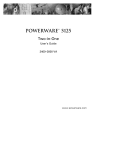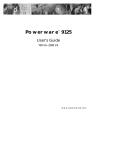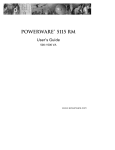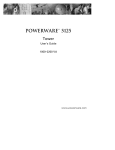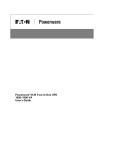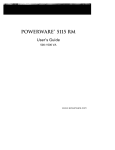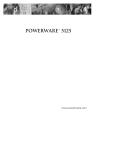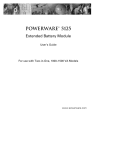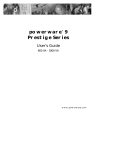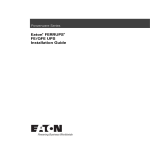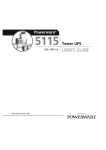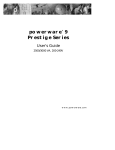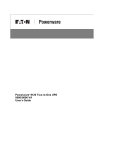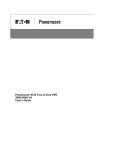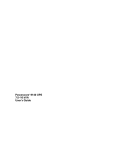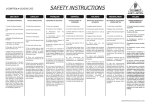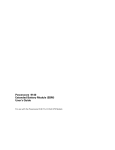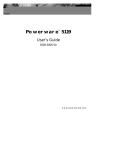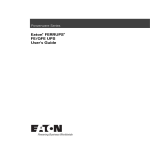Download Powerware 500VA User's Manual
Transcript
® Powerware FERRUPS FE/QFE UPS Installation Guide 500 VA–18 kVA, 50 and 60 Hz ® Powerware FERRUPS FE/QFE UPS Installation Guide 500 VA–18 kVA, 50 and 60 Hz www.powerware.com Class A EMC Statements FCC Part 15 NOTE This equipment has been tested and found to comply with the limits for a Class A digital device, pursuant to part 15 of the FCC Rules. These limits are designed to provide reasonable protection against harmful interference when the equipment is operated in a commercial environment. This equipment generates, uses, and can radiate radio frequency energy and, if not installed and used in accordance with the instruction manual, may cause harmful interference to radio communications. Operation of this equipment in a residential area is likely to cause harmful interference in which case the user will be required to correct the interference at his own expense. ICES-003 This Class A Interference Causing Equipment meets all requirements of the Canadian Interference Causing Equipment Regulations ICES-003. Cet appareil numérique de la classe A respecte toutes les exigences du Reglement sur le matériel brouilleur du Canada. For Users in Germany We hereby certify that the uninterruptible power system (QFE 500 VA, 700 VA, 850 VA, 1.15 kVA, 1.4 kVA, 1.8 kVA, 2.1 kVA, 3.1 kVA, 4.3 kVA, 5.3 kVA, 7 kVA, 10 kVA, 12.5 kVA, and 18 kVA) complies with the RFI suppression requirements of Vfg. 243/1991 and Vfg. 46/1992. The German Postal Service was notified that the equipment is being marketed. The German Postal Service has the right to retest the equipment and verify compliance. Hiermit wird bescheinigt, daß die unterbrechungsfreie Stromversorgung (QFE 500 VA, 700 VA, 850 VA, 1.15 kVA, 1.4 kVA, 1.8 kVA, 2.1 kVA, 3.1 kVA, 4.3 kVA, 5.3 kVA, 7 kVA, 10 kVA, 12.5 kVA, and 18 kVA) in Übereinstimmung mit den Bestimmungen der Vfg. 243/1991 und Vfg. 46/1992 funkentstört ist. Der Deutschen Bundespost wurde das Inverkehrbringen dieses Gerätes angezeigt und die Berechtigung zur Überprüfung der Serie auf Einhaltung der Bestimmung eingeräumt. Powerware reserves the right to change specifications without prior notice. Powerware is a registered trademark of Powerware Corporation. .Copyright 2002 Powerware, Raleigh, NC, USA. All rights reserved. No part of this document may be reproduced in any way without the express written approval of Powerware. TABLE OF CONTENTS 1 Introduction . . . . . . . . . . . . . . . . . . . . . . . . . . . . . . . . . . . . . . . . . . . . . . . . . . . . 1 Plug-Receptacle Installation . . . . . . . . . . . . . . . . . . . . . . . . . . . . . . . . . . . . . . . . . . . . . . . . . . . . . Hardwired Installation . . . . . . . . . . . . . . . . . . . . . . . . . . . . . . . . . . . . . . . . . . . . . . . . . . . . . . . . . 1 1 2 Safety Warnings . . . . . . . . . . . . . . . . . . . . . . . . . . . . . . . . . . . . . . . . . . . . . . . . 3 3 Setup . . . . . . . . . . . . . . . . . . . . . . . . . . . . . . . . . . . . . . . . . . . . . . . . . . . . . . . . . 17 Dimensions . . . . . . . . . . . . . . . . . . . . . . . . . . . . . . . . . . . . . . . . . . . . . . . . . . . . . . . . . . . . . . . . . Equipment Clearances . . . . . . . . . . . . . . . . . . . . . . . . . . . . . . . . . . . . . . . . . . . . . . . . . . . . . . . . . Location Requirements . . . . . . . . . . . . . . . . . . . . . . . . . . . . . . . . . . . . . . . . . . . . . . . . . . . . . . . . . Storage and Operating Environment . . . . . . . . . . . . . . . . . . . . . . . . . . . . . . . . . . . . . . . . . . . . . . . . 17 19 20 21 4 Electrical Installation . . . . . . . . . . . . . . . . . . . . . . . . . . . . . . . . . . . . . . . . . . . . 23 Bypass Switches . . . . . . . . . . . . . . . . . . . . . . . . . . . . . . . . . . . . . . . . . . . . . . . . . . . . . . . . . . . . . 24 5 External Bypass Switch Installation . . . . . . . . . . . . . . . . . . . . . . . . . . . . . . . . . 29 Installation Wiring Diagrams for External Bypass Switches . . . . . . . . . . . . . . . . . . . . . . . . . . . . . . . 34 6 Internal Bypass Switch Installation . . . . . . . . . . . . . . . . . . . . . . . . . . . . . . . . . 45 Installation Wiring Diagrams for Internal Bypass Switches . . . . . . . . . . . . . . . . . . . . . . . . . . . . . . . . 48 7 Battery Cabinet Installation . . . . . . . . . . . . . . . . . . . . . . . . . . . . . . . . . . . . . . . 53 Before Installing the Batteries . . . . . . . . . . . . . . . . . . . . . . . . . . . . . . . . . . . . . . . . . . . . . . . . . . . . Installing and Connecting the Batteries . . . . . . . . . . . . . . . . . . . . . . . . . . . . . . . . . . . . . . . . . . . . . Replacing the Batteries . . . . . . . . . . . . . . . . . . . . . . . . . . . . . . . . . . . . . . . . . . . . . . . . . . . . . . . . Recycling the Used Battery . . . . . . . . . . . . . . . . . . . . . . . . . . . . . . . . . . . . . . . . . . . . . . . . . . . . . . 54 56 63 64 8 Phase Check . . . . . . . . . . . . . . . . . . . . . . . . . . . . . . . . . . . . . . . . . . . . . . . . . . . 65 Powerware® FERRUPS FE/QFE UPS (500 VA–18 kVA) Installation Guide : Rev A www.powerware.com i Table of Contents ii Powerware® FERRUPS FE/QFE UPS (500 VA–18 kVA) Installation Guide : Rev A www.powerware.com CHAPTER 1 INTRODUCTION The Powerware9 FERRUPS uninterruptible power system (UPS) is available in plug-receptacle or hardwired models. The plug-receptacle models have an input plug and receptacles on the rear panel. The hardwired models have terminal strips that an electrician has to wire to AC input. See the following sections for steps on how to use this manual for your UPS installation. Plug-Receptacle Installation Only a few sections in this manual are required for installing plug-receptacle models: : Be sure to read all safety warnings before installing the UPS as stated in Chapter 2, “Safety Warnings.” : Complete Chapter 3, “Setup” for setting up the location of the UPS. : If you purchased an external battery cabinet, an electrician must wire the battery to the UPS as described in Chapter 7, “Battery Cabinet Installation.” : Continue to the startup section in the Powerware FERRUPS FE/QFE UPS (500 VA–18kVA) User’s Guide. Hardwired Installation Most of the sections in this manual are required for the electrician to install the hardwired models: : Be sure to read all safety warnings before installing the UPS as stated in Chapter 2, “Safety Warnings.” : Complete Chapter 3, “Setup” for setting up the location of the UPS. : Chapter 4, “Electrical Installation” describes the electrical requirements for hardwiring the UPS. : Continue to either Chapter 5, “External Bypass Switch Installation” or Chapter 6, “Internal Bypass Switch Installation” depending on the the type of bypass switch being installed. Powerware® FERRUPS FE/QFE UPS (500 VA–18 kVA) Installation Guide : Rev A www.powerware.com 1 Introduction : If you purchased an external battery cabinet, see Chapter 7, “Battery Cabinet Installation” for wiring connections. : Complete the phase check as described in Chapter 8, “Phase Check.” : Continue to the startup section in the Powerware FERRUPS FE/QFE UPS (500 VA–18kVA) User’s Guide. 2 Powerware® FERRUPS FE/QFE UPS (500 VA–18 kVA) Installation Guide : Rev A www.powerware.com CHAPTER 2 SAFETY WARNINGS Read the following precautions before you install the UPS. IMPORTANT SAFETY INSTRUCTIONS SAVE THESE INSTRUCTIONS. This manual contains important instructions that you should follow during installation and maintenance of the UPS and batteries. Please read all instructions before operating the equipment and save this manual for future reference. DANGER This UPS contains LETHAL VOLTAGES. All repairs and service should be performed by AUTHORIZED SERVICE PERSONNEL ONLY. There are NO USER SERVICEABLE PARTS inside the UPS. WARNING : This UPS contains its own energy source (batteries). The output receptacles may carry live voltage even when the UPS is not connected to an AC supply. : Do not remove or unplug the input cord when the UPS is turned on. This removes the safety ground from the UPS and the equipment connected to the UPS. : To reduce the risk of fire or electric shock, install this UPS in a temperature and humidity controlled, indoor environment, free of conductive contaminants. Ambient temperature must not exceed 40°C (104°F). Do not operate near water or excessive humidity (95% max). : To comply with international standards and wiring regulations, the total equipment connected to the output of this UPS must not have an earth leakage current greater than 1.5 milliamperes. Powerware® FERRUPS FE/QFE UPS (500 VA–18 kVA) Installation Guide : Rev A www.powerware.com 3 Safety Warnings CAUTION : Batteries can present a risk of electrical shock or burn from high short-circuit current. Observe proper precautions. Servicing should be performed by qualified service personnel knowledgeable of batteries and required precautions. Keep unauthorized personnel away from batteries. : Proper disposal of batteries is required. Refer to your local codes for disposal requirements. : Never dispose of batteries in a fire. Batteries may explode when exposed to flame. Sikkerhedsanvisninger VIGTIGE SIKKERHEDSANVISNINGER GEM DISSE ANVISNINGER DENNE BRUGERVEJLEDNING INDEHOLDER VIGTIGE SIKKERHEDSANVISNINGER FARE Denne UPS indeholder LIVSFARLIG HØJSPÆNDING. Alle reparationer og vedligeholdelse bør kun udføres af en AUTORISERET SERVICETEKNIKER. Ingen af UPS’ens indvendige dele kan repareres af brugeren. ADVARSEL! : Denne UPS indeholder egen energiforsyning (batterier). Udgangsnetstikkene kan lede strøm, selv når UPS’en ikke er tilsat en AC-energikilde. : Netledningen må ikke fjernes og stikket må ikke trækkes ud, mens UPS’en er tændt. Dette fjerner sikkerhedsjorden fra UPS’en og fra det udstyr, der er sat til. : Installér denne UPS i et temperatur- og fugtighedskontrolleret indendørsmiljø, frit for ledende forureningsstoffer for at formindske risikoen for brand og elektrisk stød. Rumtemperaturen må ikke overstige 40°C. UPS’en bør ikke betjenes nær vand eller høj fugtighed (maksimalt 95%). : I overensstemmelse med internationale normer og bestemmelser for el-installation må det udstyr, der er forbundet til udgangen af denne UPS, tilsammen ikke overskride en jordafdelingsspænding på mere end 1,5 milliampere. 4 Powerware® FERRUPS FE/QFE UPS (500 VA–18 kVA) Installation Guide : Rev A www.powerware.com Safety Warnings ADVARSEL : Batterier kan udgøre en fare for elektrisk stød eller forbrændinger forårsaget af høj kortslutningsspænding. De korrekte forholdsregler bør overholdes. : Korrekt bortskaffelse af batterier er påkrævet. Overhold gældende lokale regler for bortskaffelsesprocedurer. : Skaf dig aldrig af med batterierne ved at brænde dem. Batterierne kan eksplodere ved åben ild. Belangrijke Veiligheidsinstructies BELANGRIJKE VEILIGHEIDSINSTRUCTIES BEWAAR DEZE INSTRUCTIES DEZE HANDLEIDING BEVAT BELANGRIJKE VEILIGHEIDSINSTRUCTIES GEVAAR Deze UPS bevat LEVENSGEVAARLIJKE ELEKTRISCHE SPANNING. Alle reparaties en onderhoud dienen UITSLUITEND DOOR ERKEND SERVICEPERSONEEL te worden uitgevoerd. Er bevinden zich GEEN ONDERDELEN in de UPS die DOOR DE GEBRUIKER kunnen worden GEREPAREERD. WAARSCHUWING : Deze UPS bevat zijn eigen energiebron (batterijen). De uitgangsaansluitingen kunnen onder spanning staan wanneer de UPS niet op een wisselstroom voeding is aangesloten. : Verwijder de ingangsnoer niet of haal de stekker van de ingangsnoer er niet uit terwijl de UPS aan staat. Hierdoor zou de UPS en uw aangesloten apparatuur geen aardebeveiliging meer hebben. : Teneinde de kans op brand of elektrische schok te verminderen dient deze UPS in een gebouw met temperatuur- en vochtigheidregeling te worden geïnstalleerd, waar geen geleidende verontreinigingen aanwezig zijn. De omgevingstemperatuur mag 40°C niet overschrijden. Niet gebruiken in de buurt van water of bij zeer hoge vochtigheid (max. 95%). : Om aan de internationale normen en bedradingsvoorschriften te voldoen mag de gehele apparatuur die op de uitgang van deze UPS is aangesloten, geen aardlekstroom van meer dan 1,5 milliampère hebben. Powerware® FERRUPS FE/QFE UPS (500 VA–18 kVA) Installation Guide : Rev A www.powerware.com 5 Safety Warnings OPGELET : Batterijen kunnen gevaar voor elektrische schok of brandwonden veroorzaken als gevolg van un hoge kortsluitstroom. Volg de desbetreffende aanwijzingen op. : De batterijen moeten op de juiste wijze worden opgeruimd. Raadpleeg hiervoor uw plaatselijke voorschriften. : Nooit batterijen in het vuur gooien. De batterijen kunnen ontploffen. Tarkeita Turvaohjeita TÄRKEITÄ TURVAOHJEITA - SUOMI SÄILYTÄ NÄMÄ OHJEET TÄMÄ OPAS SISÄLTÄÄ TÄRKEITÄ TURVAOHJEITA VAARA Tämä UPS sisältää HENGENVAARALLISIA JÄNNITTEITÄ. Kaikki korjaukset ja huollot on jätettävä VAIN VALTUUTETUN HUOLTOHENKILÖN TOIMEKSI. UPS ei sisällä MITÄÄN KÄYTTÄJÄN HUOLLETTAVIA OSIA. VAROITUS : Tämä UPS sisältää oman energialähteen (akuston). Ulostuloliittimissä voi olla jännite, kun UPS ei ole liitettynä verkkojännitteeseen. : Älä poista tai irrota sisääntulojohtoa, kun UPS on kytkettynä. Tämä poistaa turvamaadoituksen UPS-laitteesta ja siihen liitetystä laitteistosta. : Vähentääksesi tulipalon ja sähköiskun vaaraa asenna tämä UPS sisätiloihin, joissa lämpötila ja kosteus on säädettävissä ja joissa ei ole virtaa johtavia epäpuhtauksia. Ympäristön lämpötila ei saa ylittää 40 °C. Älä käytä lähellä vettä ja vältä kosteita tiloja (95 % maksimi). : Kansainväliset normit ja johdotusmääräykset vaativat, että kaikkien tämän UPS-laitteen ulostulokytkentöjen yhteinen maavuotovirta ei ylitä 1,5 milliampeeria (mA). 6 Powerware® FERRUPS FE/QFE UPS (500 VA–18 kVA) Installation Guide : Rev A www.powerware.com Safety Warnings VARO : Akusto saattaa aiheuttaa sähköiskun tai syttyä tuleen, jos akusto kytketään oikosulkuun. Noudata asianmukaisia ohjeita. : Akusto täytyy hävittää säädösten mukaisella tavalla. Noudata paikallisia määräyksiä. : Älä koskaan heitä akkuja tuleen. Ne voivat räjähtää. Consignes de sécurité CONSIGNES DE SÉCURITÉ IMPORTANTES CONSERVER CES INSTRUCTIONS CE MANUEL CONTIENT DES CONSIGNES DE SÉCURITÉ IMPORTANTES DANGER! Cet onduleur contient des TENSIONS MORTELLES. Toute opération d’entretien et de réparation doit être EXCLUSIVEMENT CONFIÉE A UN PERSONNEL QUALIFIÉ AGRÉÉ. AUCUNE PIÈCE RÉPARABLE PAR L’UTILISATEUR ne se trouve dans l’onduleur. AVERTISSEMENT! : Cet onduleur renferme sa propre source d’énergie (batteries). Les prises de sortie peuvent être sous tension même lorsque l’onduleur n’est pas branché sur le secteur. : Ne pas retirer le cordon d’alimentation lorsque l’onduleur est sous tension sous peine de supprimer la mise à la terre de l’onduleur et du matériel connecté. : Pour réduire les risques d’incendie et de décharge électrique, installer l’onduleur uniquement à l’intérieur, dans un lieu dépourvu de matériaux conducteurs, où la température et l’humidité ambiantes sont contrôlées. La température ambiante ne doit pas dépasser 40 °C. Ne pas utiliser à proximité d’eau ou dans une atmosphère excessivement humide (95 % maximum). : Afin d’être conforme aux normes et règlements internationaux de câblage, le courant de fuite à la terre de la totalité du matériel branché sur la sortie de l’onduleur ne doit pas dépasser 1,5 mA. Powerware® FERRUPS FE/QFE UPS (500 VA–18 kVA) Installation Guide : Rev A www.powerware.com 7 Safety Warnings ATTENTION! : Les batteries peuvent présenter un risque de décharge électrique ou de brûlure par des courts-circuits de haute intensité. Prendre les précautions nécessaires. : Une mise au rebut réglementaire des batteries est obligatoire. Consulter les règlements en vigueur dans votre localité. : Ne jamais jeter les batteries au feu. L’exposition aux flammes risque de les faire exploser. Sicherheitswarnungen WICHTIGE SICHERHEITSANWEISUNGEN AUFBEWAHREN. DIESES HANDBUCH ENTHÄLT WICHTIGE SICHERHEITSANWEISUNGEN. WARNUNG Die USV führt lebensgefährliche Spannungen. Alle Reparatur- und Wartungsarbeiten sollten nur von Kundendienstfachleuten durchgeführt werden. Die USV enthält keine vom Benutzer zu wartenden Komponente. ACHTUNG : Diese USV ist mit einer eigenen Energiequelle (Batterie) ausgestattet. An den Ausgangssteckdosen kann auch dann Spannung anliegen, wenn die USV nicht an einer Wechselspannungsquelle angeschlossen ist. : Das Eingangskabel nicht entfernen oder abziehen, während die USV eingeschaltet ist, weil hierdurch die Sicherheitserdung von der USV und den daran angeschlossenen Geräten entfernt wird. : Um die Brand- oder Elektroschockgefahr zu verringern, diese USV nur in Gebäuden mit kontrollierter Temperatur und Luftfeuchtigkeit installieren, in denen keine leitenden Schmutzstoffen vorhanden sind. Die Umgebungstemperatur darf 40°C nicht übersteigen. Die USV nicht in der Nähe von Wasser oder in extrem hoher Luftfeuchtigkeit (max. 95 %) betreiben. : Um internationale Normen und Verdrahtungsvorschriften zu erfüllen, dürfen die an den Ausgang dieser USV angeschlossenen Geräte zusammen einen Erdschlußstrom von insgesamt 1,5 Milliampere nicht überschreiten. 8 Powerware® FERRUPS FE/QFE UPS (500 VA–18 kVA) Installation Guide : Rev A www.powerware.com Safety Warnings VORSICHT! : Batterien können aufgrund des hohen Kurzschlußstroms Elektroschocks oder Verbrennungen verursachen. Die entsprechenden Vorsichtsmaßnahmen sind unbedingt zu beachten. : Die Batterien müssen ordnungsgemäß entsorgt werden. Hierbei sind die örtlichen Bestimmungen zu beachten. : Batterien niemals verbrennen, da sie explodieren können. ÐñïåéäïðïéÞóåéò ÁóöÜëåéáò ÓÇÌÁÍÔÉÊÅÓ ÏÄÇÃÉÅÓ ÁÓÖÁËÅÉÁÓ ÖÕËÁÎÔÅ ÁÕÔÅÓ ÔÉÓ ÏÄÇÃÉÅÓ ÔÏ ÐÁÑÏÍ ÅÃ×ÅÉÑÉÄÉÏ ÐÅÑÉÅ×ÅÉ ÓÇÌÁÍÔÉÊÅÓ ÏÄÇÃÉÅÓ ÁÓÖÁËÅÉÁÓ ÊÉÍÄÕÍÏÓ Áõôü ôï UPS ðåñéÝ÷åé ÈÁÍÁÔÇÖÏÑÁ ÔÁÓÇ. ¼ëåò ïé åðéóêåõÝò êáé ïé óõíôçñÞóåéò ðñÝðåé íá ãßíïíôáé ÌÏÍÏ ÁÐÏ ÅÎÏÕÓÉÏÄÏÔÇÌÅÍÏ ÃÉÁ ÔÇ ÓÕÍÔÇÑÇÓÇ ÐÑÏÓÙÐÉÊÏ. Ôï UPS ÄÅÍ ÐÅÑÉÅ×ÅÉ ÊÁÍÅÍÁ ÅÎÁÑÔÇÌÁ ÐÏÕ ÍÁ ÌÐÏÑÅÉ ÍÁ ÅÐÉÓÊÅÕÁÓÔÅÉ ÁÐÏ ÔÏ ×ÑÇÓÔÇ. : ÐÑÏÅÉÄÏÐÏÉÇÓÇÊ Ôï óõãêåêñéìÝíï UPS ðåñéÝ÷åé ôç äéêÞ ôïõ ðçãÞ åíÝñãåéáò (óõóóùñåõôÝò). Ïé ñåõìáôïäüôåò åîüäïõ ìðïñåß íá Ý÷ïõí åíåñãü ôÜóç áêüìç êáé üôáí ôï UPS äåí åßíáé óõíäåäåìÝíï óå ðçãÞ åíáëëáóóüìåíïõ ñåýìáôïò (AC). : Ìçí âãÜæåôå áðü ôçí ðñßæá ôï êáëþäéï ôñïöïäïóßáò üôáí ôï UPS åßíáé áíïé÷ôü. Ì áõôü ôïí ôñüðï áöáéñåßôå ôç ãåßùóç áóöáëåßáò áðü ôï UPS êáé áðü ôïí åîïðëéóìü ðïõ åßíáé óõíäåäåìÝíïò ìå ôï UPS. : Ãéá íá ìåéþóåôå ôïí êßíäõíï ðõñêáãéÜò Þ çëåêôñïðëçîßáò, åãêáôáóôÞóôå ôï óõãêåêñéìÝíï UPS óå åóùôåñéêü ÷þñï ìå åëåã÷üìåíç èåñìïêñáóßá êáé õãñáóßá, ï ïðïßïò íá ìçí ðåñéÝ÷åé áãþãéìá õëéêÜ. Ç èåñìïêñáóßá ðåñéâÜëëïíôïò äåí ðñÝðåé íá ° C. Ìç ÷ñçóéìïðïéåßôå ôï UPS êïíôÜ óå íåñü Þ îåðåñíÜåé ôïõò 40 õðåñâïëéêÞ õãñáóßá (ìÝãéóôç ôéìÞ: 95%). Powerware® FERRUPS FE/QFE UPS (500 VA–18 kVA) Installation Guide : Rev A www.powerware.com 9 Safety Warnings : Ãéá íá óõìöùíåß ìå ôá äéåèíÞ ðñüôõðá êáé ôïõò êáíïíéóìïýò êáëùäßùóçò, ôï ñåýìá äéáññïÞò ðñïò ôç ãç ïëüêëçñïõ ôïõ åîïðëéóìïý, ðïõ åßíáé óõíäåäåìÝíïò ìå ôçí Ýîïäï ôïõ óõãêåêñéìÝíïõ UPS, äåí ðñÝðåé íá åßíáé ìåãáëýôåñï áðü 1,5 mA. : ÐÑÏÓÏ×Ç Ïé óõóóùñåõôÝò ìðïñåß íá ðñïêáëÝóïõí çëåêôñïðëçîßá Þ Ýãêáõìá áðü õøçëü ñåýìá âñá÷õêõêëþìáôïò. ËáìâÜíåôå ôéò êáôÜëëçëåò ðñïöõëÜîåéò. : Áðáéôåßôáé óùóôÞ äéÜèåóç ôùí óõóóùñåõôþí. Äåßôå ôïõò ôïðéêïýò êáíïíéóìïýò ðïõ áöïñïýí ôéò áðáéôÞóåéò äéÜèåóÞò ôïõò. : ÐïôÝ ìçí ðåôÜôå ôïõò óõóóùñåõôÝò óôç öùôéÜ, ãéáôß ìðïñåß íá åêñáãïýí. Avvisi di sicurezza IMPORTANTI ISTRUZIONI DI SICUREZZA CONSERVARE QUESTE ISTRUZIONI QUESTO MANUALE CONTIENE IMPORTANTI ISTRUZIONI DI SICUREZZA PERICOLO la TENSIONE contenuta in questo gruppo statico di continuità è LETALE. Tutte le operazioni di riparazione e di manutenzione devono essere effettuate ESCLUSIVAMENTE DA PERSONALE TECNICO AUTORIZZATO. All’interno del gruppo statico di continuità NON vi sono PARTI RIPARABILI DALL’UTENTE. AVVERTENZA : Questo gruppo statico di continuità contiene una fonte di energia autonoma (le batterie). Le prese di uscita possono condurre tensione energizzata quando il gruppo statico di continuità non è collegato con una fonte di alimentazione a corrente alternata. : Non rimuovere nè scollegare il cavo di ingresso quando il gruppo statico di continuità è acceso poichè in tal modo si disattiverebbe il collegamento a terra di sicurezza del gruppo statico di continuità e dell’apparecchiatura ad esso collegata. 10 Powerware® FERRUPS FE/QFE UPS (500 VA–18 kVA) Installation Guide : Rev A www.powerware.com Safety Warnings : Per ridurre il rischio di incendio o di scossa elettrica, installare il gruppo statico di continuità in un ambiente interno a temperatura ed umidità controllata, privo di agenti contaminanti conduttivi. La temperatura ambiente non deve superare i 40°C. Non utilizzare l’unità in prossimità di acqua o in presenza di umidità eccessiva (95% max). : Per conformità con gli standard internazionali e con le norme in merito al cablaggio, tutta l’apparecchiatura collegata con l’uscita del gruppo statico di continuità non deve avere una corrente di dispersione di terra superiore a 1,5 milliampere. ATTENZIONE : Le batterie possono presentare rischio di scossa elettrica o di ustioni provocate da alta corrente dovuta a corto circuito. Osservare le apposite istruzioni. : Le batterie devono essere smaltite in modo corretto. Per i requisiti di smaltimento fare riferimento alle disposizioni locali. : Non gettare mai le batterie nel fuoco poichè potrebbero esplodere se esposte alle fiamme. Viktig Sikkerhetsinformasion FARLIG Denne UPS’en inneholder LIVSFARLIGE SPENNINGER. All reparasjon og service må kun utføres av AUTORISERT SERVICEPERSONALE. BRUKERE KAN IKKE UTFØRE SERVICE PÅ NOEN AV DELENE i UPS’en. FARLIG : Denne UPS’en har en egen energikilde (batterier). Stikkontaktene kan være strømførende selv om UPS’en ikke er tilsluttet en vekselstrømforsyning. : Strømforsyningskabelen må ikke fjernes eller trekkes ut når UPS’en er på, slik at ikke sikkerhetsjordingen fjernes fra UPS’en og det utstyret som er forbundet med den. : For å redusere fare for brann eller elektriske støt, bør denne UPS’en installeres i et innendørs miljø med kontrollert temperatur og luftfuktighet som er fritt for ledende, forurensende stoffer. Romtemperaturen må ikke overskride 40°C. Den må ikke brukes i nærheten av vann eller ved meget høy luftfuktighet (95% maks.). Powerware® FERRUPS FE/QFE UPS (500 VA–18 kVA) Installation Guide : Rev A www.powerware.com 11 Safety Warnings : Alt utstyr som er forbundet med utgangen av denne UPS’en må ikke ha en sterkere total lekkasjestrøm enn 1,5 milliampere for å være i overensstemmelse med internasjonale standarder og forkablingsbestemmelser. FORSIKTIG : Batterier kan forårsake elektriske støt eller forbrenning på grunn av høy kortslutningsstrøm. Følg instruksene. : Batterier må fjernes på korrekt måte. Se lokale forskrifter vedrørende krav om fjerning av batterier. : Kast aldri batterier i flammer, da de kan eksplodere, hvis de utsettes for åpen ild. Regulamentos de Segurança INSTRUÇÕES DE SEGURANÇA IMPORTANTES GUARDE ESTAS INSTRUÇÕES ESTE MANUAL CONTÉM INSTRUÇÕES DE SEGURANÇA IMPORTANTES CUIDADO A UPS contém VOLTAGEM MORTAL. Todos os reparos e assistência técnica devem ser executados SOMENTE POR PESSOAL DA ASSISTÊNCIA TÉCNICA AUTORIZADO. Não há nenhuma PEÇA QUE POSSA SER REPARADA PELO USUÁRIO dentro da UPS. ADVERTÊNCIA : Esta UPS contém sua própria fonte de energia (baterias). Os receptáculos de saída podem conter voltagem ativa quando a UPS não se encontra conectada a uma fonte de alimentação de corrente alternada. : Não remova ou desconecte o cabo de entrada quando a UPS estiver ligada. Isto removerá o aterramento de segurança da UPS e do equipamento conectado. : Para reduzir o risco de incêndios ou choques elétricos, instale a UPS em ambiente interno com temperatura e umidade controladas e livres de contaminadores condutíveis. A temperatura ambiente não deve exceder 40°C. Não opere próximo a água ou em umidade excessiva (máx: 95%). : Para estar de acordo com os padrões internacionais e os regulamentos de fiação, o equipamento total conectado à saída desta UPS não deve ter uma corrente de fuga à terra maior que 1,5 miliampères. 12 Powerware® FERRUPS FE/QFE UPS (500 VA–18 kVA) Installation Guide : Rev A www.powerware.com Safety Warnings PERIGO : As baterias podem apresentar o risco de choque elétrico, ou queimaduras provenientes de alta corrente de curto-circuito. Observe as instruções adequadas. : Siga as instruções apropriadas ao desfazer-se das baterias. Consulte os códigos do local para maiores informações sobre os regulamentos de descarte de produtos. : Nunca jogue as baterias no fogo, porque há risco de explosão. Предупреждения по мерам безопасности ВАЖНЫЕ УКАЗАНИЯ ПО МЕРАМ БЕЗОПАСНОСТИ СОХРАНИТЕ ЭТИ УКАЗАНИЯ ДАННОЕ РУКОВОДСТВО СОДЕРЖИТ ВАЖНЫЕ УКАЗАНИЯ ПО МЕРАМ БЕЗОПАСНОСТИ ОПАСНО В данном ИБП имеются СМЕРТЕЛЬНО ОПАСНЫЕ НАПРЯЖЕНИЯ. Все работы по ремонту и обслуживанию должны выполняться ТОЛЬКО УПОЛНОМОЧЕННЫМ ОБСЛУЖИВАЮЩИМ ПЕРСОНАЛОМ. Внутри ИБП нет узлов, ОБСЛУЖИВАЕМЫХ ПОЛЬЗОВАТЕЛЕМ. ПРЕДУПРЕЖДЕНИЕ : Данный ИБП содержит собственные источники энергии (аккумуляторы). На выходных розетках может иметься напряжение, даже когда ИБП не подключен к сети переменного тока. : Не отсоединяйте сетевой шнур и не извлекайте его вилку из розетки при включенном ИБП. При этом защитное заземление отключается от ИБП и от оборудования, подключенного к ИПБ. : Для снижения опасности пожара или поражения электрическим током устанавливайте ИБП в закрытом помещении с контролируемыми температурой и влажностью, в котором отсутствуют проводящие загрязняющие вещества. Температура окружающего воздуха не должна превышать 40°С. Не эксплуатируйте устройство около воды или в местах с повышенной влажностью (макс. 95%). Powerware® FERRUPS FE/QFE UPS (500 VA–18 kVA) Installation Guide : Rev A www.powerware.com 13 Safety Warnings : Для обеспечения соблюдения требований международных стандартов и требований к разводке электрических цепей, суммарная величина тока утечки на землю всего оборудования, подключенного к выходу ИБП, не должна превышать 1,5 миллиампера. ОСТОРОЖНО : Аккумуляторы могут вызвать опасность поражения электрическим током или ожога от тока короткого замыкания. Соблюдайте соответствующие меры предосторожности. : Необходимо соблюдать правила утилизации аккумуляторов. Обратитесь к местным нормативным актам за информацией о требованиях к утилизации. : Никогда не бросайте аккумуляторы в огонь. Аккумуляторы могут взорваться под воздействием огня. Advertencias de Seguridad INSTRUCCIONES DE SEGURIDAD IMPORTANTES GUARDE ESTAS INSTRUCCIONES ESTE MANUAL CONTIENE INSTRUCCIONES DE SEGURIDAD IMPORTANTES PELIGRO Este SIE contiene VOLTAJES MORTALES. Todas las reparaciones y el servicio técnico deben ser efectuados SOLAMENTE POR PERSONAL DE SERVICIO TÉCNICO AUTORIZADO. No hay NINGUNA PARTE QUE EL USUARIO PUEDA REPARAR dentro del SIE. ADVERTENCIA : Este SIE contiene su propia fuente de energía (las baterías). Los receptáculos de salida pueden transmitir corriente eléctrica aun cuando el SIE no esté conectado a un suministro de corriente alterna (c.a.). : No retire o desenchufe el cable de entrada mientras el SIE se encuentre encendido. Esto suprime la descarga a tierra de seguridad del SIE y de los equipos conectados al SIE. 14 Powerware® FERRUPS FE/QFE UPS (500 VA–18 kVA) Installation Guide : Rev A www.powerware.com Safety Warnings : Para reducir el riesgo de incendio o de choque eléctrico, instale este SIE en un lugar cubierto, con temperatura y humedad controladas, libre de contaminantes conductores. La temperatura ambiente no debe exceder los 40°C. No trabaje cerca del agua o con humedad excesiva (95% máximo). : Para cumplir con los estándares internacionales y las normas de instalación, la totalidad de los equipos conectados a la salida de este SIE no debe tener una intensidad de pérdida a tierra superior a los 1,5 miliamperios. PRECAUCIÓN : Las baterías pueden presentar un riesgo de descargas eléctricas o de quemaduras debido a la alta corriente de cortocircuito. Preste atención a las instrucciones correspondientes. : Es necesario desechar las baterías de un modo adecuado. Consulte las normas locales para conocer los requisitos pertinentes. : Nunca deseche las baterías en el fuego. Las baterías pueden explotar si se las expone a la llama. Säkerhetsföreskrifter VIKTIGA SÄKERHETSFÖRESKRIFTER SPARA DESSA FÖRESKRIFTER DENNA BRUKSANVISNING INNEHÅLLER VIKTIGA SÄKERHETSFÖRESKRIFTER FARA Denna UPS-enhet innehåller LIVSFARLIG SPÄNNING. ENDAST AUKTORISERAD SERVICEPERSONAL får utföra reparationer eller service. Det finns inga delar som ANVÄNDAREN KAN UTFÖRA SERVICE PÅ inuti UPS-enheten. VARNING : Denna UPS-enhet har en egen energikälla (batterier). De utgående kontakterna kan vara strömförande när UPS-enheten inte är ansluten till en växelströmkälla. : Ta aldrig bort nätsladden när UPS-enheten är påslagen. Detta tar bort skyddsjordningen från både UPS-enheten och den anslutna utrustningen. Powerware® FERRUPS FE/QFE UPS (500 VA–18 kVA) Installation Guide : Rev A www.powerware.com 15 Safety Warnings : Minska risken för brand eller elektriska stötar genom att installera denna UPS-enhet inomhus, där temperatur och luftfuktighet är kontrollerade och där inga ledande föroreningar förekommer. Omgivande temperatur får ej överstiga 40°C. Använd inte utrustningen nära vatten eller vid hög luftfuktighet (max 95 %). : För att överensstämma med internationell standard och installationsföreskrifter får inte den totala utrustning som anslutits till uttagen på denna UPS-enhet ha läcksström som överstiger 1,5 milliampere. VIKTIGT : Batterierna kan ge elektriska stötar eller brännskador från hög kortslutningsström. Följ tillämpliga anvisningar. : Batterierna måste avyttras enligt anvisningarna i lokal lagstiftning. : Använda batterier får aldrig brännas upp. De kan explodera. 16 Powerware® FERRUPS FE/QFE UPS (500 VA–18 kVA) Installation Guide : Rev A www.powerware.com CHAPTER 3 SETUP This chapter explains the requirements for setting up the UPS: : : : : : UPS, battery cabinet, and bypass switch dimensions Equipment clearances Location requirements Moving the UPS and batteries Storage and operating environment Dimensions Table 1. FERRUPS FE/QFE 500 VA–3.1 kVA Dimensions Dimensions (See Figure 1) Height (A) Width (B) Depth (C) 122 (30.5 cm) 102 (25.5 cm) 21.252 (54.0 cm) 1.15 kVA and 1.4 kVA 15.12 (38.5 cm) 15.22 (39.0 cm) 20.22 (51.5 cm) 1.8 kVA, 2.1 kVA, and 3.1 kVA 21.22 (54.0 cm) 15.252 (39.0 cm) 22.92 (58.5 cm) UPS Model 500 VA, 700 VA, and 850 VA D A F C B E Figure 1. UPS Dimensions Powerware® FERRUPS FE/QFE UPS (500 VA–18 kVA) Installation Guide : Rev A www.powerware.com 17 Setup Table 2. FERRUPS FE/QFE 4.3–18 kVA Dimensions Dimensions (See Figure 1) Height (D) Width (E) UPS Model Depth without Internal Bypass (F) Depth with Internal Bypass Switch (F) 4.3 kVA and 5.3 kVA 29.52 (75.0 cm) 15.52 (39.5 cm) 252 (63.5 cm) 332 (84.0 cm) 7 kVA, 10 kVA, 12.5 kVA, and 18 kVA 36.52 (93.0 cm) 322 (81.5 cm) 402 (102.0 cm) 192 (48.5 cm) Table 3. Battery Cabinet Dimensions Dimensions (See Figure 2) Height Width Depth ASY-0468 12.252 (31.5 cm) 15.752 (40.0 cm) 28.52 (72.5 cm) ASY-0386 372 (94.0 cm) 192 (48.5 cm) 322 (81.5 cm) ASY-0387 492 (124.5 cm) 152 (38.5 cm) 322 (81.5 cm) ASY-0385 and ASY-0685 512 (129.5 cm) 302 (76.5 cm) 322 (81.5 cm) Model Figure 2. Battery Cabinet Dimensions Table 4. Bypass Switch Dimensions Dimensions (See Figure 3) Model A B C D E BPE-01 122 (30.5 cm) 62 (15.2 cm) 132 (33.0 cm) 102 (25.4 cm) 32 (7.6 cm) BPE-02 162 (40.6 cm) 82 (20.3 cm) 172 (43.2 cm) 122 (30.5 cm) 72 (17.8 cm) BPE-04 and BPE-05 172 (43.2 cm) 122 (30.5 cm) 182 (45.7 cm) 162 (40.6 cm) 92 (22.9 cm) 18 Powerware® FERRUPS FE/QFE UPS (500 VA–18 kVA) Installation Guide : Rev A www.powerware.com Setup B A E C E B A C D D BPE-01 BPE-02, 04, and 05 Figure 3. Bypass Switch Dimensions Equipment Clearances All cabinet sizes require the following clearances to allow for servicing and adequate ventilation: Table 5. Clearances for the UPS and Battery Cabinets Dimensions (see Figure 4) Sides (G) Front (H) Top (I) Back (J) 362 (91.5 cm) 362 (91.5 cm) 122 (30.5 cm) 42 (10.0 cm) NOTE A minimum clearance of 42 (10 cm) is required on the sides, front, and back and 122 (30.5 cm) above the UPS for proper ventilation. NOTE For 4.3–18 kVA models with an internal bypass switch, measure from the back of the switch. Powerware® FERRUPS FE/QFE UPS (500 VA–18 kVA) Installation Guide : Rev A www.powerware.com 19 Setup I I J G H G H Figure 4. Installation and Service Clearances Location Requirements Install the FERRUPS as close as possible to the equipment to be protected. If the UPS is more than 25 ft (7.6m) from the equipment, transient noise can reappear in the electrical distribution system. The UPS should be well ventilated and away from direct sunlight or other heat source. The environment can affect the reliability and performance of both the UPS and the batteries. Verify the storage and operating environmental requirements on page 21. If additional FERRUPS system batteries are in a separate external battery cabinet, the cabinet should be located as close as possible to the FERRUPS UPS. If the batteries will be further from the unit than the standard cables allow, contact your service representative or your local distributor for assistance. 20 Powerware® FERRUPS FE/QFE UPS (500 VA–18 kVA) Installation Guide : Rev A www.powerware.com Setup Storage and Operating Environment Storage Temperature: Store the batteries (in the UPS or external battery cabinet) at -20° to +40°C (-4° to +104°F). Batteries will have a longer shelf life if they are kept below 25°C (77°F). The UPS or external battery cabinet without batteries may be stored at -20° to +60°C (-4° to +140°F). Ventilation: The air around the UPS must be clean and free of dust, corrosive chemicals, and other contaminants. The air must be free to circulate around the UPS and battery cabinet(s). NOTE Do not place the UPS or batteries in a sealed room or container. Operating Temperature: The UPS can operate from 0° to +40°C (+32° to +104°F). Do not operate near water or excessive humidity (95% max). For full battery life, keep the UPS at an ambient temperature of 25°C (77°F). High Altitude Operation: The maximum operating temperature drops 1°C per 300m (2°F per 1000 ft) above sea level. Maximum elevation is 3000m (10,000 ft). Powerware® FERRUPS FE/QFE UPS (500 VA–18 kVA) Installation Guide : Rev A www.powerware.com 21 Setup 22 Powerware® FERRUPS FE/QFE UPS (500 VA–18 kVA) Installation Guide : Rev A www.powerware.com CHAPTER 4 ELECTRICAL INSTALLATION NOTE If you have a plug-receptacle unit, continue to “Battery Cabinet Installation” on page 53 to install optional battery cabinets or to the startup section in the Powerware FERRUPS FE/QFE UPS (500 VA–18 kVA) User’s Guide. WARNING Only qualified service personnel (such as a licensed electrician) should perform the hardwired installation. Risk of electrical shock. Before installing your UPS, complete the following information: 1. From the ID label on the UPS rear panel: Model number: Input voltage: Output voltage: 2. From the bypass switch label: Model number: Internal or External? Make-Before-Break (MBB) or Break-Before-Make (BBM)? 3. Verify that the UPS input and output voltages are what is required for your application: Does the input voltage for the UPS at the AC service panel match the input voltage in Step 1? Does the output voltage in Step 1 match the output voltage of the equipment you are using with the UPS? NOTE The FERRUPS provides single-phase power only. 4. If you answered NO to either question in Step 3, contact your service representative or your local distributor for assistance. Powerware® FERRUPS FE/QFE UPS (500 VA–18 kVA) Installation Guide : Rev A www.powerware.com 23 Electrical Installation Bypass Switches Bypass switches are available in two types: external (a separate cabinet that is wall-mounted) or internal (attached to the back of the UPS). The bypass switch has three positions as described in Table 6. Table 6. Bypass Switch Positions Switch Position Description LINE Connects the load directly to AC input power and disconnects UPS output. AC input power is still connected to the UPS input. OFF Disconnects the load from the UPS output power and AC input power. UPS Connects the UPS output to the load. NOTE In all three positions, AC input power is still connected to the input terminals inside the UPS (once the UPS is installed). Use the AC disconnect switch (located on the right side of the bypass switch) to disconnect AC input power during maintenance or service. Bypass switches may be MBB or BBM. An MBB switch makes a new connection before it breaks the original connection. For example, if you turn an MBB switch from UPS to LINE, the bypass switch connects the load to AC input power before disconnecting the load from UPS output power. NOTE MBB switches are not for use with 208 Vac. A BBM switch breaks the original connection before it makes a new one. If you turn a BBM switch from UPS to LINE, the switch disconnects the load from UPS output power before connecting the load to AC input power. 24 Powerware® FERRUPS FE/QFE UPS (500 VA–18 kVA) Installation Guide : Rev A www.powerware.com Electrical Installation Table 7 and Table 8 show the bypass switch models available for the FERRUPS UPS. Table 7. External Bypass Switch Specifications Model Number Ratings (UL/CSA) Continuous Ratings (TÜV) Continuous Weight BPE-01 30A/300 Vac 30A/300 Vac 8.25 lb/3.7 kg BPE-02 40A/300 Vac 50A/300 Vac 19.75 lb/9 kg BPE-04 80A/300 Vac 80A/300 Vac 30 lb/13.6 kg BPE-05 104A/300 Vac 120A/300 Vac 32.75 lb/14.9 kg Table 8. Internal Bypass Switch Specifications Model Number Ratings (UL/CSA) Continuous Ratings (TÜV) Continuous BPI-02 40A/300 Vac 50A/300 Vac BPI-03 46A/ 300 Vac 55A/300 Vac BPI-04 80A/ 300 Vac 80A/300 Vac BPI-05 104A/300 Vac 120A/300 Vac Figure 5 shows a UPS with a separate battery cabinet and an external bypass switch. Continue to Chapter 5, “External Bypass Switch Installation” on page 29 for electrical connections. Powerware® FERRUPS FE/QFE UPS (500 VA–18 kVA) Installation Guide : Rev A www.powerware.com 25 Electrical Installation External Bypass Switch Building Service Panel AC Disconnect Line Bypass Switch Off Off Load Distribution Panel UPS On Connect to (DC) External Batteries UPS Figure 5. Typical Hardwired Installation with External Bypass Switch 26 Powerware® FERRUPS FE/QFE UPS (500 VA–18 kVA) Installation Guide : Rev A www.powerware.com Electrical Installation Figure 6 shows a UPS with a separate battery cabinet and an internal bypass switch. Internal bypass switches are available only for FE/QFE 4.3–18 kVA models. Continue to Chapter 6, “Internal Bypass Switch Installation” on page 45 for electrical connections. Back of UPS Internal Bypass Switch Building Service Panel AC Disconnect Bypass Switch Line Off Off Load Distribution Panel UPS On Connect to (DC) if there are External Batteries Figure 6. Typical Hardwired Installation with Internal Bypass Switch Powerware® FERRUPS FE/QFE UPS (500 VA–18 kVA) Installation Guide : Rev A www.powerware.com 27 Electrical Installation 28 Powerware® FERRUPS FE/QFE UPS (500 VA–18 kVA) Installation Guide : Rev A www.powerware.com CHAPTER 5 EXTERNAL BYPASS SWITCH INSTALLATION WARNING Only qualified service personnel (such as a licensed electrician) should perform the hardwired installation. Risk of electrical shock. CAUTION Before you install the bypass switch, verify that the bypass switch and the AC disconnect switch are in the OFF position. 1. Identify the installation wiring diagram that applies to your FERRUPS (see Table 9). Table 9. External Bypass Switch Wiring Diagrams Model (Frequency) FE 500 VA–3.1 kVA (60H ) (60Hz) QFE 500 VA–3.1 kVA (50 Hz) H) FE 1.15 kVA–3.1 kVA (60 Hz) UPS Input Voltage UPS Output Voltage Bypass Switch Type Wiring Diagram 120 120 MBB or BBM Figure 8 on page 36 208 or 240 120/208 or 120/240 MBB or BBM For 208V, use BBM only Figure 9 on page 37 208 or 480 source*/ 240 input 120/240 MBB or BBM Figure 10 on page 38 120 120 MBB or BBM Figure 8 on page 36 220, 230, 240 220, 230, 240 MBB or BBM Figure 11 on page 39 220 220 BBM Figure 8 on page 36 *With a step-up or step-down transformer. **Contact your service representative for (a) single-phase installations that do not have the same input and output voltage, or (b) split-phase installations that require 220 Vac. Powerware® FERRUPS FE/QFE UPS (500 VA–18 kVA) Installation Guide : Rev A www.powerware.com 29 External Bypass Switch Installation Model (Frequency) FE 4.3–18 kVA (60 Hz) QFE 4.3–18 kVA (50 Hz) UPS Input Voltage UPS Output Voltage Bypass Switch Type Wiring Diagram 120 (4.3–7 kVA only) 120 MBB or BBM Figure 12 on page 40 208 or 240 120/208 or 120/240 MBB or BBM For 208V, use BBM only Figure 13 on page 41 208 or 480 source*/ 240 input 120/240 MBB or BBM Figure 14 on page 42 220** 220 BBM Figure 15 on page 43 220, 230, or 240 220, 230, or 240 MBB or BBM Figure 15 on page 43 *With a step-up or step-down transformer. **Contact your service representative for (a) single-phase installations that do not have the same input and output voltage, or (b) split-phase installations that require 220 Vac. 30 Powerware® FERRUPS FE/QFE UPS (500 VA–18 kVA) Installation Guide : Rev A www.powerware.com External Bypass Switch Installation 2. Review the installation wiring diagram and applicable notes to find the proper circuit breaker size for your installation. In the US, see Table 10 to size the wire. In other areas, use 75°C copper wire and size according to the local code. Table 10. Recommended Wire Sizes Input Circuit Breaker Size 75°C Copper Wire Size 15A, 20A 12 AWG (3.3 mm2) 25A, 30A 10 AWG (5.3 mm2) 35A, 40A, 45A, 50A 8 AWG (8.4 mm2) 60A 6 AWG (13.3 mm2) 70A, 80A 4 AWG (21.2 mm2) 90A, 100A 3 AWG (26.7 mm2) 110A 2 AWG (33.6 mm2) 125A 1 AWG (42.1 mm2) 150A 1/0 AWG (53.5 mm2) FOR US INSTALLATIONS, READ THIS IMPORTANT NOTE! This table lists the AWG and mm2 wire size for each circuit breaker size shown on the wiring diagrams. The minimum recommended circuit breaker sizes for each model and voltage application are listed on the wiring diagrams. Conductor sizes shall be no smaller than the 75°C wire size based on the ampacities given in Table 310–16 of the National Electrical Code, ANSI/NFPA 70-1999, and article 220. All circuit conductors, including the neutral and equipment grounding conductors, must be the same size (ampacity) wire. Code may require a larger AWG size than shown in this table because of temperature, number of conductors in the conduit, or long service runs. Follow local code requirements. 3. Mount the bypass switch within sight of the UPS. If you do not have a Powerware bypass switch with an AC disconnect switch or the fuse box or panel is out of sight, you must install a separate disconnect switch next to the UPS. 4. Remove the screws in the lower part of the bypass switch front cover and remove the lower cover panel. Remove the knockouts or plugs in the bottom of the bypass switch for AC Line Input, AC to UPS Input, AC from UPS Output, and AC to the UPS load. Powerware® FERRUPS FE/QFE UPS (500 VA–18 kVA) Installation Guide : Rev A www.powerware.com 31 External Bypass Switch Installation CAUTION To prevent electrical shock or damage to your equipment, verify that the UPS ON/OFF switch is in the OFF position before you remove the UPS front cover panel. The circuit breaker or disconnect switch must be turned off at the AC input service panel. 5. Remove the UPS front cover panel according to the UPS model: FE or QFE 500 VA–3.1 kVA : Remove the #1 Phillips grounding screw on top of the UPS. : Remove and save the sticker in the lower right corner of the UPS front cover panel with the Powerware logo. : Use a #2 Phillips screwdriver to loosen (but not remove) the screw. : Slide the UPS front cover panel forward until it is completely off the UPS. FE or QFE 4.3–18 kVA : Remove the screws on the UPS side panels using a Phillips screwdriver. : Loosen (but do not remove) the three Phillips screws on the bar across the top of the UPS. : Slide the top of the UPS side panels out. : Lift the panels to remove them. 6. Remove the knockouts in the UPS rear panel for AC Input and AC Output. If your UPS has a separate battery cabinet, also remove the knockout for DC. 7. Install the conduit adapters. AC Input and AC Output conductors must be run through separate pieces of conduit. UPS output circuits shall be installed in dedicated conduit systems and not shared with other electrical circuits. CAUTION To prevent electrical shock or damage to your equipment, verify that the AC input is OFF at the service panel and the bypass and AC disconnect switches are in the OFF position before you connect any wires to the bypass switch terminal strip. 32 Powerware® FERRUPS FE/QFE UPS (500 VA–18 kVA) Installation Guide : Rev A www.powerware.com External Bypass Switch Installation 8. Find the terminal strip inside the bypass switch. Using the label on the back of the switch’s lower front cover panel, wire the terminal strip and tighten all connections securely. Use copper wire and the appropriate wire size for the current. See Figure 7 for sample terminal strip labels. BPE-01 BPE-02, BPE-04, and BPE-05 Figure 7. External Bypass Switch Terminal Strip Labels 9. Using the installation wiring diagram, wire the UPS terminal strip and complete the AC wiring. NOTE Terminal strip connections should be exactly as shown in the installation wiring diagram to ensure proper phasing. Good ground connections are necessary to reduce electrical noise and ensure safe operation of the UPS and the load. Powerware® FERRUPS FE/QFE UPS (500 VA–18 kVA) Installation Guide : Rev A www.powerware.com 33 External Bypass Switch Installation 10. If your UPS does not have an external battery cabinet(s), continue to “Phase Check” on page 65. If your UPS has an external battery cabinet(s), continue to “Battery Cabinet Installation” on page 53. Installation Wiring Diagrams for External Bypass Switches The following notes are referenced in the external bypass switch wiring diagrams (Figure 8 through Figure 15). To determine which diagram is correct for your site, see Table 9 on page 29. NOTE 1 The customer must provide input overcurrent protection as stated in NEC Section 240-21 or local codes. Size the protection device according to local code requirements. NOTE 2 The UPS bypass switch/AC disconnect must be installed within sight of the UPS. To properly install, complete the phase check starting on page 65. NOTE 3 The customer must provide and install this ground connection according to NEC Sections 250-20(d), 250-30, 250-62, and 250-64 or local requirements. This grounding electrode conductor must be at least #8 AWG (8.36 mm)), per NEC table 250-66. If the UPS input circuit conductors are larger than #8 AWG (8.36 mm)), Powerware requires the grounding electrode conductor to be the same size (ampacity) as the largest UPS input circuit conductor. Refer to NEC Section 110-3(b). Conduit is not considered an acceptable grounding electrode conductor. Powerware does not recommend routing the grounding electrode conductor through metallic conduit. This conductor may require protection from physical damage according to local requirements. NOTE 4 All circuit conductors, including the neutral and equipment grounding conductors, must be the same size (ampacity) and have the same rating (75°C copper wire), and must be sized according to the input protection device. NOTE 5 The customer must provide output overcurrent protection as stated in NEC Section 240-21 or local codes. Size the protection device according to local code requirements. NOTE 6 For maximum protection against electrical noise, use isolated ground receptacles. Refer to NEC Section 250-146(d) or local requirements. NOTE 7 For service, the UPS requires 362 (91.5 cm) clearance on the sides and in front, 122 (30.5 cm) above the UPS, and 42 (10.0 cm) behind the UPS. A minimum clearance of 42 (10 cm) is required on the sides, front, and back and 122 (30.5 cm) above the UPS for proper ventilation. See “Equipment Clearances” on page 19 for clearances before installing the UPS. Use flexible metal conduit on the UPS or the external battery cabinet if either must be moved. 34 Powerware® FERRUPS FE/QFE UPS (500 VA–18 kVA) Installation Guide : Rev A www.powerware.com External Bypass Switch Installation NOTE 8 External UPS batteries are optional. The battery cable must not be disconnected if a load is applied. Shut off the UPS before disconnecting the cable. See “Battery Cabinet Installation” on page 53 for external battery cabinet installation. NOTE 9 UPS output circuits must be installed in dedicated conduit and not shared with other electrical circuits. NOTE 10 The load fuse or circuit breaker should be sized to match the load current requirements. NOTE 11 For 208 Vac, use a step-up transformer. For 480 Vac, use a step-down transformer. Use an isolation transformer with a 120/240 grounded center-tapped neutral output. Do not use a buck/boost transformer. NOTE 12 For 120/208/240 models, connect X1 on the UPS to L1 on the bypass switch; for 208 Vac, connect the bypass switch L2 to the UPS XT1; for 240 Vac, connect the bypass switch L2 to the UPS XT2. Powerware® FERRUPS FE/QFE UPS (500 VA–18 kVA) Installation Guide : Rev A www.powerware.com 35 External Bypass Switch Installation QFE: 50 Hz 120 Vac Input and Output OR FE: 60 Hz 120 Vac Input and Output OR FE 1.15–3.1 kVA only: 60 Hz 220 Vac Input and Output (with single-voltage output) For 220 Vac, use only a BBM switch. Figure 8. FE or QFE 500 VA–3.1 kVA UPS with External Bypass Switch Table 11. Minimum Recommended Circuit Breakers for 60 Hz 120 Vac Charger 500 VA, 700 VA, and 850 VA 1.15 kVA 1.4 kVA 1.8 kVA 2.1 kVA 3.1 kVA Standard 15 15 15 20 25 35 20 20 40 45 50 15A Table 12. Input Current for 50 Hz 120 Vac - Size Overcurrent Protection According to Local Code Voltage and Charger 500 VA 700 VA 850 VA 1.15 kVA 1.4 kVA 1.8 kVA 2.1 kVA 3.1 kVA 120V, Standard Charger 4.4A 5.8A 7.0A 8.4A 11A 15A 16A 24A 120V, 15A Charger 8.9A 11A 12A 13A 14A 27A 28A 35A Table 13. Input Current for 60 Hz 220 Vac - Size Overcurrent Protection According to Local Code 60 Hz Voltage 1.15 kVA 1.4 kVA 1.8 kVA 2.1 kVA 3.1 kVA 220V, Standard Charger 4.6A 5.8A 7.8A 9.4A 12A 220V, 15A Charger 7A 8A 15A 17A 21A 36 Powerware® FERRUPS FE/QFE UPS (500 VA–18 kVA) Installation Guide : Rev A www.powerware.com External Bypass Switch Installation 60 Hz 208 Vac or 240 Vac Input - 120/208 Vac or 120/240 Vac Output For 208 Vac, use only a BBM switch. Figure 9. FE 500 VA–3.1 kVA UPS with External Bypass Switch Table 14. Minimum Recommended Circuit Breakers for 208 Vac or 240 Vac 208 Vac Charger 500 VA –1.4 kVA 240 Vac 1.8 kVA 2.1 kVA 3.1 kVA 500 VA –1.4 kVA 1.8 kVA 2.1 kVA 3.1 kVA Standard 15 15 15 20 15 15 15 15 15A 15 20 25 30 15 20 20 25 Powerware® FERRUPS FE/QFE UPS (500 VA–18 kVA) Installation Guide : Rev A www.powerware.com 37 External Bypass Switch Installation 60 Hz 208 or 480 Source/240 Vac Input - 120/240 Vac Output (with Transformer) Figure 10. FE 500 VA–3.1 kVA UPS with External Bypass Switch Table 15. Minimum Recommended Circuit Breakers for 240 Vac Charger 500 VA–1.4 kVA 1.8 kVA 2.1 kVA 3.1 kVA Standard 15 15 15 15 15A 15 20 20 25 38 Powerware® FERRUPS FE/QFE UPS (500 VA–18 kVA) Installation Guide : Rev A www.powerware.com External Bypass Switch Installation 50 Hz 220, 230, or 240 Vac Input and Output Figure 11. QFE 500 VA–3.1 kVA UPS with External Bypass Switch Table 16. Input Current - Size Overcurrent Protection According To Local Code Voltage Charger 500 VA 700 VA 850 VA 1.15 kVA 1.4 kVA 1.8 kVA 2.1 kVA 3.1 kVA 220 Vac Standard 2.6A 3.9A 4.4A 4.9A 5.7A 7.9A 8.2A 13A 15A 4.7A 6.0A 6.5A 7.0A 7.8A 14A 15A 19A Standard 2.5A 3.8A 4.2A 4.6A 5.4A 7.5A 7.8A 12A 15A 4.6A 5.9A 6.3A 6.7A 7.5A 14A 14A 18A Standard 2.4A 3.5A 4.0A 4.4A 5.2A 7.2A 7.4A 12A 15A 4.6A 5.7A 6.2A 6.6A 7.4A 14A 14A 19A 230 Vac 240 Vac Powerware® FERRUPS FE/QFE UPS (500 VA–18 kVA) Installation Guide : Rev A www.powerware.com 39 External Bypass Switch Installation 60 Hz 120 Vac Input - 120 Vac Output Figure 12. FE 4.3–7 kVA UPS with External Bypass Switch Table 17. Minimum Recommended Circuit Breakers for 120 Vac Charger 4.3 kVA 5.3 kVA 7 kVA Standard 40 50 70 10A 45 60 70 20A 50 60 70 40 Powerware® FERRUPS FE/QFE UPS (500 VA–18 kVA) Installation Guide : Rev A www.powerware.com External Bypass Switch Installation 60 Hz 208 Vac or 240 Vac Input - 120/208 Vac or 120/240 Vac Output For 208 Vac, use only a BBM switch. Figure 13. FE 4.3–18 kVA UPS with External Bypass Switch Table 18. Minimum Recommended Circuit Breakers for 208 Vac or 240 Vac 208 Vac 240 Vac Charger 4.3 kVA 5.3 kVA 7 kVA 10 kVA 12.5 kVA 18 kVA 4.3 kVA 5.3 kVA 7 kVA 10 kVA 12.5 kVA 18 kVA Standard 25 30 40 60 80 110 20 25 35 50 70 100 10A 25 30 40 70 80 125 20 30 35 60 70 100 20A 30 35 40 70 90 125 25 35 35 60 80 110 Powerware® FERRUPS FE/QFE UPS (500 VA–18 kVA) Installation Guide : Rev A www.powerware.com 41 External Bypass Switch Installation 60 Hz 208 or 480 Source/240 Vac Input - 120/240 Vac Output (with Transformer) Figure 14. FE 4.3–18 kVA UPS with External Bypass Switch Table 19. Minimum Recommended Circuit Breakers for 240 Vac Charger 4.3 kVA 5.3 kVA 7 kVA 10 kVA 12.5 kVA 18 kVA Standard 20 25 35 50 70 100 10A 20 30 35 60 70 100 20A 20 35 35 60 80 110 42 Powerware® FERRUPS FE/QFE UPS (500 VA–18 kVA) Installation Guide : Rev A www.powerware.com External Bypass Switch Installation QFE: 50 Hz 220, 230, or 240 Vac Input and Output OR FE: 60 Hz 220 Vac Input and Output For FE 60 Hz 220 Vac, use only a BBM switch. Figure 15. FE or QFE 4.3–18 kVA UPS with External Bypass Switch Table 20. Input Current - Size Overcurrent Protection According To Local Code Voltage Charger 4.3 kVA 5.3 kVA 7 kVA 10 kVA 12.5 kVA 18 kVA 60 Hz 220 VVac Standard 17A 21A 27A 41A 53A 81A 10A 18A 23A 28A 49A 60A 85A 20A 20A 25A 30A 52A 65A 89A Standard 19A 21A 27A 43A 55A 81A 10A 22A 23A 28A 46A 58A 84A 20A 23A 25A 29A 51A 63A 89A Standard 18A 20A 26A 41A 53A 78A 10A 20A 22A 27A 44A 56A 81A 20A 21A 24A 28A 49A 60A 85A Standard 17A 19A 24A 39A 51A 75A 10A 19A 21A 26A 43A 54A 78A 20A 20A 23A 27A 47A 58A 82A 50 Hz 220 VVac 50 Hz 230 VVac 50 Hz 240 VVac Powerware® FERRUPS FE/QFE UPS (500 VA–18 kVA) Installation Guide : Rev A www.powerware.com 43 External Bypass Switch Installation 44 Powerware® FERRUPS FE/QFE UPS (500 VA–18 kVA) Installation Guide : Rev A www.powerware.com CHAPTER 6 INTERNAL BYPASS SWITCH INSTALLATION WARNING Only qualified service personnel (such as a licensed electrician) should perform the hardwired installation. Risk of electrical shock. CAUTION Before you install the bypass switch, verify that the bypass switch and the AC disconnect switch are in the OFF position. 1. Identify the installation wiring diagram that applies to your FERRUPS (see Table 21). Table 21. Internal Bypass Switch Wiring Diagrams Model (Frequency) FE 4.3–18 kVA (60 Hz) QFE 4.3–18 kVA (50 Hz) UPS Input Voltage UPS Output Voltage Bypass Switch Type Wiring Diagram 120 (4.3–7 kVA only) 120 MBB or BBM Figure 17 on page 49 208 or 240 120/208 or 120/240 MBB or BBM For 208V, use BBM only Figure 18 on page 50 208 or 480 source*/ 240 input 120/240 MBB or BBM Figure 19 on page 51 220** 220 BBM Figure 20 on page 52 220, 230, or 240 220, 230, or 240 MBB or BBM Figure 20 on page 52 *With a step-up or step-down transformer. **Contact your service representative for (a) single-phase installations that do not have the same input and output voltage, or (b) split-phase installations that require 220 Vac. Powerware® FERRUPS FE/QFE UPS (500 VA–18 kVA) Installation Guide : Rev A www.powerware.com 45 Internal Bypass Switch Installation 2. Review the installation wiring diagram and applicable notes to find the proper circuit breaker size for your installation. In the U.S., see Table 22 to size the wire. In other areas, use 75°C copper wire and size according to the local code. Table 22. Recommended Wire Sizes Input Circuit Breaker Size 75°C Copper Wire Size 15A, 20A 12 AWG (3.3 mm2) 25A, 30A 10 AWG (5.3 mm2) 35A, 40A, 45A, 50A 8 AWG (8.4 mm2) 60A 6 AWG (13.3 mm2) 70A, 80A 4 AWG (21.2 mm2) 90A, 100A 3 AWG (26.7 mm2) 110A 2 AWG (33.6 mm2) 125A 1 AWG (42.1 mm2) 150A 1/0 AWG (53.5 mm2) FOR U.S. INSTALLATIONS, READ THIS IMPORTANT NOTE! This table lists the AWG and mm2 wire size for each circuit breaker size shown on the wiring diagrams. The minimum recommended circuit breaker sizes for each model and voltage application are listed on the wiring diagrams. Conductor sizes shall be no smaller than the 75°C wire size based on the ampacities given in Table 310–16 of the National Electrical Code, ANSI/NFPA 70-1999, and article 220. All circuit conductors, including the neutral and equipment grounding conductors, must be the same size (ampacity) wire. Code may require a larger AWG size than shown in this table because of temperature, number of conductors in the conduit, or long service runs. Follow local code requirements. 3. Remove the screws in the lower part of the bypass switch front cover and remove the lower cover panel. Remove the knockouts or plugs in the bottom of the bypass switch for AC Line Input, AC from UPS Output, and AC to the UPS load. 4. Install the conduit adapters. AC Input and AC Output conductors must be run through separate pieces of conduit. UPS output circuits shall be installed in dedicated conduit systems and not shared with other electrical circuits. 46 Powerware® FERRUPS FE/QFE UPS (500 VA–18 kVA) Installation Guide : Rev A www.powerware.com Internal Bypass Switch Installation CAUTION To prevent electrical shock or damage to your equipment, verify that the AC input is OFF at the service panel and the bypass and AC disconnect switches are in the OFF position before you connect any wires to the bypass switch terminal strip. 5. Find the terminal strip inside the bypass switch. Using the label on the back of the switch’s lower front cover panel, wire the terminal strip and tighten all connections securely. Use copper wire and the appropriate wire size for the current. See Figure 16 for a sample terminal strip label. Figure 16. Internal Bypass Switch (BPI) Terminal Strip Label 6. Using the installation wiring diagram, wire the UPS-internal bypass terminal strip and complete the AC wiring. NOTE Terminal strip connections should be exactly as shown in the installation wiring diagram to ensure proper phasing. Good ground connections are necessary to reduce electrical noise and ensure safe operation of the UPS and the load. 7. If your UPS does not have an external battery cabinet(s), continue to “Phase Check” on page 65. If your UPS has an external battery cabinet(s), continue to “Battery Cabinet Installation” on page 53. Powerware® FERRUPS FE/QFE UPS (500 VA–18 kVA) Installation Guide : Rev A www.powerware.com 47 Internal Bypass Switch Installation Installation Wiring Diagrams for Internal Bypass Switches The following notes are referenced in the internal bypass switch wiring diagrams (Figure 17 through Figure 20). To determine which diagram is correct for your site, see Table 21 on page 45. NOTE 1 The customer must provide input overcurrent protection as stated in NEC Section 240-21 or local codes. Size the protection device according to local code requirements. NOTE 2 To properly install, complete the phase check starting on page 65. NOTE 3 The customer must provide and install this ground connection according to NEC Sections 250-20(d), 250-30, 250-62, and 250-64 or local requirements. This grounding electrode conductor must be at least #8 AWG (8.36 mm2), per NEC table 250-66. If the UPS input circuit conductors are larger than #8 AWG (8.36 mm2), Powerware requires the grounding electrode conductor to be the same size (ampacity) as the largest UPS input circuit conductor. Refer to NEC Section 110-3(b). Conduit is not considered an acceptable grounding electrode conductor. Powerware does not recommend routing the grounding electrode conductor through metallic conduit. This conductor may require protection from physical damage according to local requirements. NOTE 4 All circuit conductors, including the neutral and equipment grounding conductors, must be the same size (ampacity) and have the same rating (75°C copper wire), and must be sized according to the input protection device. NOTE 5 The customer must provide output overcurrent protection per NEC Section 240-21 or local codes. Size the protection device according to local code requirements. NOTE 6 For maximum protection against electrical noise, use isolated ground receptacles. Refer to NEC Section 250-146(d) or local requirements. NOTE 7 For service, the UPS requires 362 (91.5 cm) clearance on the sides and in front, 122 (30.5 cm) above the UPS, and 42 (10.0 cm) behind the bypass switch. A minimum clearance of 42 (10 cm) is required on the sides, front, and back and 122 (30.5 cm) above the UPS for proper ventilation. See “Equipment Clearances” on page 19 for clearances before installing the UPS. Use flexible metal conduit on the UPS or the external battery cabinet if either must be moved. NOTE 8 External UPS batteries are optional. The battery cables are connected to the DC terminals on the DIN RAIL in the UPS. See “Battery Cabinet Installation” on page 53 for external battery cabinet installation. NOTE 9 UPS output circuits shall be installed in dedicated conduit systems and not shared with other electrical circuits. 48 Powerware® FERRUPS FE/QFE UPS (500 VA–18 kVA) Installation Guide : Rev A www.powerware.com Internal Bypass Switch Installation NOTE 10 The load fuse or circuit breaker should be sized to match the load current requirements. NOTE 11 For 208 Vac, use a step-up transformer For 480 Vac, use a step-down transformer. Use an isolation transformer with a 120/240 grounded center-tapped neutral output. Do not use a buck/boost transformer. 60 Hz 120 Vac Input - 120 Vac Output Figure 17. FE 4.3–7 kVA UPS with Internal Bypass Switch Table 23. Minimum Recommended Circuit Breakers for 120 Vac Charger 4.3 kVA 5.3 kVA 7 kVA Standard 40 50 70 10A 45 60 70 20A 50 60 70 Powerware® FERRUPS FE/QFE UPS (500 VA–18 kVA) Installation Guide : Rev A www.powerware.com 49 Internal Bypass Switch Installation 60 Hz 208 Vac or 240 Vac Input - 120/208 Vac or 120/240 Vac Output For 208 Vac, use only a BBM switch. Figure 18. FE 4.3–18 kVA UPS with Internal Bypass Switch Table 24. Minimum Recommended Circuit Breakers for 208 Vac or 240 Vac 208 Vac 240 Vac Charger 4.3 kVA 5.3 kVA 7 kVA 10 kVA 12.5 kVA 18 kVA 4.3 kVA 5.3 kVA 7 kVA 10 kVA 12.5 kVA 18 kVA Standard 25 30 40 60 80 110 20 25 35 50 70 100 10A 25 30 40 70 80 125 20 30 35 60 70 100 20A 30 35 40 70 90 125 25 35 35 60 80 110 50 Powerware® FERRUPS FE/QFE UPS (500 VA–18 kVA) Installation Guide : Rev A www.powerware.com Internal Bypass Switch Installation 60 Hz 208 or 480 Source/240 Vac Input - 120/240 Vac Output (with Transformer) Figure 19. FE 4.3–18 kVA UPS with Internal Bypass Switch Table 25. Minimum Recommended Circuit Breakers for 240 Vac Charger 4.3 kVA 5.3 kVA 7 kVA 10 kVA 12.5 kVA 18 kVA Standard 20 25 35 50 70 100 10A 20 30 35 60 70 100 20A 25 35 35 60 80 110 Powerware® FERRUPS FE/QFE UPS (500 VA–18 kVA) Installation Guide : Rev A www.powerware.com 51 Internal Bypass Switch Installation QFE: 50 Hz 220, 230, or 240 Vac Input and Output FE: 60 Hz 220 Vac Input and Output For FE 60 Hz 220 Vac, use only a BBM switch. Figure 20. FE or QFE 4.3–18 kVA UPS with Internal Bypass Switch Table 26. Input Current - Size Overcurrent Protection According To Local Code Voltage Charger 4.3 kVA 5.3 kVA 7 kVA 10 kVA 12.5 kVA 18 kVA 60 Hz 220 VVac Standard 17A 21A 27A 41A 53A 81A 10A 18A 23A 28A 49A 60A 85A 20A 20A 25A 30A 52A 65A 89A Standard 19A 21A 27A 43A 55A 81A 10A 22A 23A 28A 46A 58A 84A 20A 23A 25A 29A 51A 63A 89A Standard 18A 20A 26A 41A 53A 78A 10A 20A 22A 27A 44A 56A 81A 20A 21A 24A 28A 49A 60A 85A Standard 17A 19A 24A 39A 51A 75A 10A 19A 21A 26A 43A 54A 78A 20A 20A 23A 27A 47A 58A 82A 50 Hz 220 VVac 50 Hz 230 VVac 50 Hz 240 VVac 52 Powerware® FERRUPS FE/QFE UPS (500 VA–18 kVA) Installation Guide : Rev A www.powerware.com CHAPTER 7 BATTERY CABINET INSTALLATION NOTE If you have an optional Floor Saver battery cabinet, see the Floor Saver instructions that came with your FERRUPS UPS. WARNING Only qualified service personnel (such as a licensed electrician) should perform the electrical installation. Risk of electrical shock. CAUTION Full voltage and current are always present at the battery terminals. The batteries used in this system can produce dangerous voltages, extremely high currents and a risk of electric shock. They may cause severe injury if the terminals are shorted together or to ground (earth). You must be extremely careful to avoid electric shock and burns caused by contacting battery terminals or shorting terminals during battery installation. Do not touch uninsulated battery terminals. Any battery used with this UPS shall comply with the applicable requirements for batteries in the standard for emergency lighting and power equipment, UL 924. Cabinets are designed to be used with, and batteries must be replaced with, Powerware battery number BAT-XXXX or equivalent. The electrician must take these precautions: : Wear protective clothing and eye wear. For 120V battery systems, wear rubber gloves and boots. Batteries contain caustic acids and toxic materials and can rupture or leak if mistreated. Remove rings and metal wristwatches or other metal objects and jewelry. Don’t carry metal objects in your pockets where the objects can fall into the battery cabinet. : Tools must have insulated handles and must be insulated so that they will not short battery terminals. Do not allow a tool to short a battery terminal to another battery terminal or to the cabinet at any time. Do not lay tools or metal parts on top of the batteries, and do not lay them where they could fall onto the batteries or into the cabinet. : Install the batteries as shown on the drawing provided with the batteries. When connecting cables, never allow a cable to short across a battery’s terminals, the string of batteries, or to the cabinet. Powerware® FERRUPS FE/QFE UPS (500 VA–18 kVA) Installation Guide : Rev A www.powerware.com 53 Battery Cabinet Installation : Align the cables on the battery terminals so that the cable lug will not contact any part of the cabinet even if the battery is moved. Keep the cable away from any sharp metal edges. : Install the battery cables so they cannot be pinched by the battery cabinet or UPS doors. : Make sure the fuse is positioned so that it will not contact any cabinet parts or other battery posts if the batteries should move. Make sure that there is enough clearance when the cabinet door closes. : Battery cabinet chassis (ground or earth) must be connected to the UPS chassis (ground or earth). If you use conduit, this ground conductor must be routed in the same conduit as the battery conductors. : Where conductors may be exposed to physical damage, protect the conductors in accordance with ANSI/NFPA 70-1993. : If you are replacing batteries or repairing battery connections, follow the procedure in the Powerware FERRUPS FE/QFE UPS (500 VA–18kVA) User’s Guide to shut off your UPS and remove both AC and DC input power. Before Installing the Batteries The following items are required for battery installation. Use only tools with insulated handles: : : : : : : : : : : : 54 Torque wrench calibrated in inch pounds or Newton meters Petroleum jelly or conductive grease Brush (to apply petroleum jelly or conductive grease to terminals) Pliers 92 extension Standard and Phillips screwdrivers Volt-ohm meter Hammer 7/162 socket wrench Electrical tape Ratchet Powerware® FERRUPS FE/QFE UPS (500 VA–18 kVA) Installation Guide : Rev A www.powerware.com Battery Cabinet Installation Table 27. Nominal DC Battery Voltage Models Nominal Battery Voltage QFE 500 VA, 700 VA, 850 VA, 1.15 kVA, and 1.4 kVA 12 Vdc FE 500 VA, 700 VA, and 850 VA 24 Vdc QFE 1.8 kVA, 2.1 kVA, 3.1 kVA, 4.3 kVA, 5.3 kVA, and 7 kVA FE 1.15 kVA, 1.4 kVA, 1.8 kVA, 2.1 kVA, 3.1 kVA, 4.3 kVA, 5.3 kVA, and 7 kVA 48 Vdc FE and QFE 10 kVA, 12.5 kVA, and 18 kVA 120 Vdc The battery cable or wire used is #1 AWG (42.11 mm2) for all applications with the following exceptions: : 18 kVA models use #1/0 (53.49 mm2) battery cables. : If the batteries must be some distance from the UPS, you may need to install larger battery cables between the battery cabinets and the UPS. Using long cable runs and larger diameter cables may require modifications inside the UPS; call your service representative if you did not order the longer, larger-diameter cable with the UPS. The UPS must have a DC disconnect switch or a removable plug so you can disconnect external batteries from the UPS. : FE/QFE 500 VA–3.1 kVA models have a removable plug at the UPS; the battery cabinet may also have a DC switch. : Most FE/QFE 4.3–18 kVA models have a DC switch at the battery cabinet. However, some may have a removable plug at the cabinet or between the UPS and the batteries, and others may have an external DC switch. FE/QFE 4.3–18 kVA models also have a DC switch behind the front cover panel. Powerware® FERRUPS FE/QFE UPS (500 VA–18 kVA) Installation Guide : Rev A www.powerware.com 55 Battery Cabinet Installation Installing and Connecting the Batteries 1. Use the battery installation diagram that came with your UPS batteries and cabinet as you follow the steps below. 2. Place the battery cabinet or rack as close as possible to the FERRUPS UPS. If the batteries will be further from the unit than the standard cables allow, contact your service representative or your local distributor for assistance. The battery cabinet or rack should be well ventilated and away from direct sunlight or other heat source. Ensure that the floor is level and can support the weight of the batteries, the cabinet or rack, and any other necessary equipment. Your Powerware sales coordinator can tell you the size and weight of external batteries. The temperature should be below 77°F (25°C) for the best battery performance. Batteries will be less efficient at temperatures below 65°F (18°C). High temperatures will reduce battery life. Typically, at about 95°F (35°C) battery life will be half of what it would be at a normal temperature of 77°F (25°C). At about 113°F (45°C), battery life will be one-fourth of normal. The batteries should be as close as possible to the UPS to reduce DC wiring costs and improve battery performance. NOTE If you are installing the batteries in a place where there may be seismic activity, you should anchor the UPS and battery cabinets to the floor. Anchoring kits are available from Powerware. 3. Wherever conductors may be exposed to physical damage, you must protect the conductors in accordance with National Electrical Code ANSI/NFPA 70-1993. This includes battery cables between the UPS and the battery cabinet and cables between battery cabinets (if you have more than one). We suggest routing battery cables through flexible conduit. For models with a removable DC plug at the UPS end of the cables, we suggest routing the cables through the conduit to within about 122 (30.5 cm) of the UPS because the connector or plug does not connect to flexible conduit. Install flexible conduit for battery cables according to local or national code. 56 Powerware® FERRUPS FE/QFE UPS (500 VA–18 kVA) Installation Guide : Rev A www.powerware.com Battery Cabinet Installation 4. The battery cabinet ground (or earth) must be connected to the UPS chassis ground (or earth). You must make a good connection to the battery cabinet chassis ground (or earth). If the battery cabinet has a terminal strip, you can make the ground connection at the terminal strip ground (or earth) lug inside the cabinet. If not, you can make the ground connection at one of the screws on the battery cabinet; to ensure a good connection, remove the paint under the cabinet screw. At the UPS, the procedure for connecting ground depends on your model. FE/QFE 500 VA–3.1 kVA: At the UPS, connect the ground wire to the ground lug (the green screw on the back of the UPS). This UPS ground (or earth) screw is marked with the label shown below. CABINET GROUND Figure 21. Ground Label FE/QFE 4.3–18 kVA: At the UPS, find the green/yellow terminal strip next to the UPS battery terminals. This green and yellow terminal strip is labeled “GROUNDING ELECTRODE TERMINAL;” it also has the ground or earth symbol shown below. Connect the ground wire to this ground terminal. OR Figure 22. Ground Symbol CAUTION Do not make connections to the RS-232 communication port if the UPS is connected to a positive ground battery system. The RS-232 ground must be isolated to prevent equipment damage. For assistance, call your service representative. Powerware® FERRUPS FE/QFE UPS (500 VA–18 kVA) Installation Guide : Rev A www.powerware.com 57 Battery Cabinet Installation 5. Arrange the batteries in the cabinet or rack. If optional straps are included, install the straps as shown in the battery installation diagram that was packed with your batteries. Arrange the batteries so there is as much air flow as possible around the batteries and so the batteries can be cooled as much as possible. Some battery cabinets have cooling slots cut in the shelves to increase air flow. Arrange the batteries so these slots are not blocked. Some larger batteries must sit with the longest battery dimension in the same direction as the longest shelf dimension. These batteries will partly block the cooling slots. However, if you place the batteries next to the outside edge of the shelf to leave as much space between the batteries as possible, there will be plenty of air flow for cooling. CAUTION Never install the batteries in an air-tight enclosure. 6. All FE and QFE models with external batteries use a fuse in the external battery cabinet. The external battery cabinet fuse protects the battery cables. The battery installation diagram shows the fuse type and position. A system DC fuse is inside the UPS. Connect the DC fuse(s) as shown in the battery installation diagram. (The fuse may be on the terminal strip.) 7. Find the battery cable assembly that connects to the UPS. (If you have a removable DC plug at the UPS end, note that this end of the cables does not go through the conduit or connect to it.) Do not connect the external battery cables to the UPS at this time, but pull them through the conduit from the UPS to the rack or cabinet. Do not connect the cables to the batteries or cabinet terminals yet. If you have more than one external battery cabinet, find the battery cable assembly that will connect the battery cabinets. Pull the cables through the conduit that you installed between the cabinets. 58 Powerware® FERRUPS FE/QFE UPS (500 VA–18 kVA) Installation Guide : Rev A www.powerware.com Battery Cabinet Installation NOTE If you have an external DC disconnect switch between the UPS and batteries, see the instructions that came with your disconnect switch. 8. Clean the cable and battery post (terminal) before you make the battery connection. Apply a thin coating of high-temperature conductive grease on the post and cable terminals to slow corrosion. If you use a nonconductive grease like petroleum jelly, do not apply any grease before you make the connections. Instead, make the connection first; then, torque it to the torque values shown below for your battery. After you have made the connection, apply a coating of the nonconductive grease to the hardware at the battery terminals. When you make battery terminal connections, use the torque wrench to tighten the battery terminal connections securely. For most batteries, you can find out what torque value to use by finding the battery number (BAT-XXXX) on the top of the battery. Then, use Table 28 to find the torque value for that battery. Table 28. Battery Torque Value Battery Type Torque BAT-0046 Torque to 65 in lb (7.3 Nm) BAT-0048 Torque to 65 in lb (7.3 Nm) BAT-0050 Torque to 75 in lb (8.4 Nm) BAT-0053 Torque to 40 in lb (4.5 Nm) BAT-0103 Torque to 40 in lb (4.5 Nm) BAT-0122 Torque to 65 in lb (7.3 Nm) Other batteries do not have a battery number on the top. To find the torque value for these batteries, check the battery terminal type; then, use Figure 23 to find the torque value for that terminal type. Powerware® FERRUPS FE/QFE UPS (500 VA–18 kVA) Installation Guide : Rev A www.powerware.com 59 Battery Cabinet Installation Square: Torque to Modified Square: Torque 17 in lb or 1.9 Nm. (BAT-0058) to 35 in lb or 3.9 Nm. (BAT-0065) Screw Posts: Torque to 85 in lb or 9.6 Nm. (BAT-0071) Figure 23. Battery Terminal Types Connect the battery cables between batteries as shown in the battery installation diagram. Do not connect the cables between battery strings or between the UPS and the batteries yet. If you are only using one string of batteries, go to step 11. 9. If you are connecting more than one battery string, connect the positive cables as shown in the battery installation diagram. Next, use the voltmeter to check the DC voltage between the negative terminals of the strings. The measured voltage should be less than three volts. If it is more than three volts, correct any wiring errors before you go on. 10. Use the cables provided to connect the negative (–) battery terminals of the battery strings as shown in the battery installation diagram. If the battery cabinet has a DC switch, the DC switch has been installed at the factory. 11. To connect external batteries to your UPS, follow the instructions for your model: FE or QFE 500 VA 3.1 kVA If your battery cabinet has a DC switch, make sure the switch is is in the OFF position; then, find the battery cables between the UPS and the batteries. The removable DC connector at one end of the cables connects to the UPS, and the other ends of the positive and negative cables connect to the external batteries. You should connect the cables to the batteries first. Refer to the battery installation diagram as you follow the steps below. 60 Powerware® FERRUPS FE/QFE UPS (500 VA–18 kVA) Installation Guide : Rev A www.powerware.com Battery Cabinet Installation : If your battery cabinet has a DC switch on the front, the positive and negative cables connect to the terminal strip in the back of the battery cabinet. First, find the positive (+) cable, and strip 0.52 (1.3 cm) of insulation from the end. Insert the cable into the positive (+) battery cabinet terminal. Next, strip 0.52 (1.3 cm) of insulation from the end of the negative (–) cable, and connect that cable to the negative (–) terminal in the battery cabinet. Tighten both terminal connections securely. If your battery cabinet does NOT have a DC switch, see your battery installation diagram. Connect the positive (+) cable to the DC fuse, and connect the negative (–) battery cable to the most negative terminal on your batteries. NOTE If you have an external DC disconnect switch, see the instructions that came with your disconnect switch. : Now, connect the battery cables to the UPS by plugging the removable DC connector into the matching connector on the back of the UPS. : If the battery cabinet has a DC switch, turn the switch to the ON position. FE or QFE 4.3 18 kVA Make sure the UPS DC Switch is in the OFF position; then, find the battery cables that you will connect between the UPS and the batteries. Connect the cables to the UPS first; to do this, strip 0.52 (1.3 cm) of insulation from the end of the negative (–!) and positive (+) cables. Next, connect the negative (–!) cable to the negative (–!) terminal on the UPS terminal strip; then, connect the positive (+) cable to the positive (+) terminal on the UPS terminal strip. Tighten the terminal connections securely. Now, go to the batteries. Find the positive (+) and negative (–) cables that come from the UPS and strip 0.52 (1.3 cm) of insulation from the end of each cable. Insert the positive (+) cable into the positive (+) terminal at the back of the battery cabinet. Next, connect the negative (–) cable to the negative (–) terminal at the back of the battery cabinet. Tighten the terminal connections securely. Powerware® FERRUPS FE/QFE UPS (500 VA–18 kVA) Installation Guide : Rev A www.powerware.com 61 Battery Cabinet Installation NOTE If you have an external DC disconnect switch, see the instructions that came with your disconnect switch. Now, turn the DC ON/OFF switch on the battery cabinet(s) to the ON position. Leave the UPS DC switch in the OFF position. 12. Use the meter to check for proper nominal DC voltage at the UPS end of the cable. Make sure the polarity agrees with the markings on the UPS battery terminals. Table 29. Nominal Battery Voltage Models Nominal Battery Voltage QFE 500 VA, 700 VA, 850 VA, 1.15 kVA, and 1.4 kVA 12 Vdc FE 500 VA, 700 VA, and 850 VA 24 Vdc QFE 1.8 kVA, 2.1 kVA, 3.1 kVA, 4.3 kVA, 5.3 kVA, and 7 kVA FE 1.15 kVA, 1.4 kVA, 1.8 kVA, 2.1 kVA, 3.1 kVA, 4.3 kVA, 5.3 kVA, and 7 kVA 48 Vdc FE and QFE 10 kVA, 12.5 kVA, and 18 kVA 120 Vdc After you have checked the DC voltage, turn the DC switch on the battery cabinet(s) to the OFF position. 13. Complete the phase check beginning on page 8. 62 Powerware® FERRUPS FE/QFE UPS (500 VA–18 kVA) Installation Guide : Rev A www.powerware.com Battery Cabinet Installation Replacing the Batteries CAUTION Only qualified service personnel (such as a licensed electrician) should perform the battery installation. Risk of electrical shock. Consider all warnings, cautions, and notes before replacing batteries. WARNING : Batteries can present a risk of electrical shock or burn from high short-circuit current. The following precautions should be observed: 1) Remove watches, rings, or other metal objects; 2) Use tools with insulated handles; 3) Do not lay tools or metal parts on top of batteries. : ELECTRIC ENERGY HAZARD. Do not attempt to alter any battery wiring or connectors. Attempting to alter wiring can cause injury. : Replace batteries with the same number and type of batteries as originally installed in the UPS. To replace the batteries: 1. Use the same number and type of battery. To ensure continued superior performance of your UPS and to maintain proper charger operation, you must replace the batteries in the UPS or its battery cabinets or racks with the same number of batteries. These batteries must be the same type as the original batteries: valve-regulated, low-maintenance. The replacement batteries should have the same voltage and ampere-hour rating as the original batteries. 2. Remove the ground from the battery terminal. If your local or national code requires you to ground either battery terminal, remove the connection from the terminal to ground (or earth) before you work on the batteries. If any battery terminal is inadvertently grounded, remove the source of the ground. Contacting any part of a grounded battery can cause a risk of electric shock. An electric shock will be less likely if you disconnect the grounding connection before you work on the batteries. Powerware® FERRUPS FE/QFE UPS (500 VA–18 kVA) Installation Guide : Rev A www.powerware.com 63 Battery Cabinet Installation 3. Handle used batteries with care! Assume that old batteries are fully charged. Use the same precautions you would use when handling a new battery. Do not short battery terminals or the battery string with a cable or tool when you disconnect the batteries! See “Recycling the Used Battery” on page 64 for proper disposal. Recycling the Used Battery Contact your local recycling or hazardous waste center for information on proper disposal of the used battery. WARNING : Do not dispose of the battery or batteries in a fire. Batteries may explode. Proper disposal of batteries is required. Refer to your local codes for disposal requirements. : Do not open or mutilate the battery or batteries. Released electrolyte is harmful to the skin and eyes. It may be toxic. CAUTION Do not discard the UPS or the UPS batteries in the trash. This product contains sealed, lead-acid batteries and must be disposed of properly. For more information, contact your local recycling or hazardous waste center. 64 Powerware® FERRUPS FE/QFE UPS (500 VA–18 kVA) Installation Guide : Rev A www.powerware.com CHAPTER 8 PHASE CHECK After all hardwired connections are complete (including external battery cabinets, if applicable), complete the phase check using the following steps. You will need an AC voltmeter for the phase check. CAUTION Before operating the bypass switch, use the following procedure to check the wiring for correct installation. To prevent damage to the load, turn off the main circuit breaker in the load service panel or verify that the load cannot receive power from the UPS. 1. Confirm that an electrician has completed and tested the connection to the proper power source. 2. Verify that the bypass switch is in the OFF position. 3. At the UPS AC input service panel, turn on the input power to the UPS and the bypass switch. 4. Turn on the AC disconnect switch. The AC LINE indicator on the UPS illuminates. NOTE The AC LINE indicator does not illuminate for FE models with serial numbers 25000 and greater until the UPS ON/OFF switch is turned to the ON position. 5. If your UPS has a DC switch, turn on the switch according to the UPS model: 500 VA–3.1 kVA: Most units do not have a DC switch on the UPS or external battery cabinet(s). If the external battery cabinet has a DC switch, turn the switch to the ON position. 4.3–7 kVA: If you have an external battery cabinet(s) with a DC switch, turn the switch to the ON position. If you do not have an external battery cabinet(s): unlock the UPS front cover panel using the FERRUPS key and remove the front cover panel. Locate the DC switch behind the UPS front cover panel. If there is a precharge button next to the switch, press it for a few seconds. Turn the DC switch to the ON position and reinstall the UPS front cover panel. Powerware® FERRUPS FE/QFE UPS (500 VA–18 kVA) Installation Guide : Rev A www.powerware.com 65 Phase Check 10–18 kVA: If you have an external battery cabinet(s) with a DC switch, turn the switch to the ON position. 6. Turn the UPS ON/OFF switch to the ON position. The switch is located on the back of the 500 VA–3.1 kVA models and on the front of the 4.3–18 kVA models. The load should still be disconnected at this time. After a short startup test, the READY indicator blinks for a few seconds and then remains illuminated. The UPS is ready to supply output power. 7. Turn the bypass switch to the UPS position. 8. Use an AC voltmeter to measure voltages on the terminal strip inside the bypass switch cabinet (refer to the label on the back of the switch’s lower front cover panel for the terminal numbers). Record your measurements in the following chart according to the type of bypass switch installed. The voltages in the first column should be nearly equal to the voltages in the second column. If the values differ by more than a few volts, check the terminal strip connections and correct any wiring problems. CAUTION If the AC input voltage is 208V, measure 88 Vac between the AC output terminals: : Internal Bypass Switch: 6 and 7 or 6 and 8 : External Bypass Switch: N and X1 or N and X2 DO NOT connect any 120V LOAD to the 88V terminals. Internal Bypass Switch AC to UPS Load 66 Measurement AC Line Input Measurement X1 to X2 Vac L1 to L2 Vac N to X1 Vac N to L1 Vac N to X2 Vac N to L1 Vac Powerware® FERRUPS FE/QFE UPS (500 VA–18 kVA) Installation Guide : Rev A www.powerware.com Phase Check External Bypass Switch BPE-01 AC from UPS Output Measurement 5 to 6 Vac AC Line Input 8 to 9 Measurement Vac BPE-02, BPE-04, or BPE-05 AC from UPS Output Measurement AC Line Input Measurement 7 to 8* Vac 11 to 12 Vac 6 to 7 Vac 10 to 11 Vac 6 to 8* Vac 10 to 12 Vac *60 Hz, 208 or 240V only. 9. If the bypass switch is a Break-Before-Make type, skip this step and proceed to Step 10. If the bypass switch is a Make-Before-Break type, verify that the AC voltages from the UPS and the AC line input are in phase. Measure the voltage between the following points on the terminal strip. These measurements must be no more than 100 Vac; if they are, call your service representative. Internal Bypass Switch X1 to L1 Vac X2 to L2* Vac *60 Hz, 208 or 240V only. External Bypass Switch (BPE-01) 6 to 9 Vac External Bypass Switch (BPE-02, BPE-04, or BPE-05) 7 to 11 Vac 8 to 12* Vac *60 Hz, 208 or 240V only. Powerware® FERRUPS FE/QFE UPS (500 VA–18 kVA) Installation Guide : Rev A www.powerware.com 67 Phase Check 10. Measure the AC voltage between the following points on the terminal strip. This reading must be no more than 1 Vac; if it is, call your service representative. Internal Bypass Switch N (AC to UPS Load) to N (AC Line Input) Vac External Bypass Switch (BPE-01) 5 to 8 Vac External Bypass Switch (BPE-02, BPE-04, or BPE-05) 6 to 10* Vac 8 to 12** Vac *60 Hz, 208 or 240V only. **60 Hz, 120V or 50 Hz, 220/230/240V. 11. Turn the bypass switch to the LINE position. Measure the voltage to the protected equipment (at the load distribution panel or the UPS-protected receptacles for your equipment) and verify that it is correct. 12. Turn the bypass switch to the UPS position and verify the voltage to the protected equipment is still correct. 13. Turn the bypass switch back to the LINE position. 14. Reinstall the bypass switch and UPS front cover panels. 15. Turn the UPS ON/OFF switch to the OFF position. 68 Powerware® FERRUPS FE/QFE UPS (500 VA–18 kVA) Installation Guide : Rev A www.powerware.com Phase Check 16. Turn off the DC switch, if applicable, according to your UPS model: 500 VA–3.1 kVA: If you have an external battery cabinet(s) with a DC switch, turn the switch to the OFF position. 4.3–7 kVA: If you have an external battery cabinet(s) with a DC switch, turn the switch to the OFF position. If you do not have an external battery cabinet(s): unlock the UPS front cover panel using the FERRUPS key and remove the front cover panel. Locate the DC switch behind the front cover panel. Turn the DC switch to the OFF position. 10–18 kVA: If you have an external battery cabinet(s) with a DC switch, turn the switch to the OFF position. 17. Reinstall the UPS front cover panel. 18. Turn the AC disconnect switch to the OFF position. 19. If the UPS will not be operated immediately, leave the bypass switch in the LINE position and turn on your protected equipment. 20. The equipment will not be protected by the UPS until you start up the UPS and turn the bypass switch to the UPS position. Refer to the startup section in the Powerware FERRUPS FE/QFE UPS (500 VA–18 kVA) User’s Guide. Powerware® FERRUPS FE/QFE UPS (500 VA–18 kVA) Installation Guide : Rev A www.powerware.com 69 Phase Check 70 Powerware® FERRUPS FE/QFE UPS (500 VA–18 kVA) Installation Guide : Rev A www.powerware.com












































































